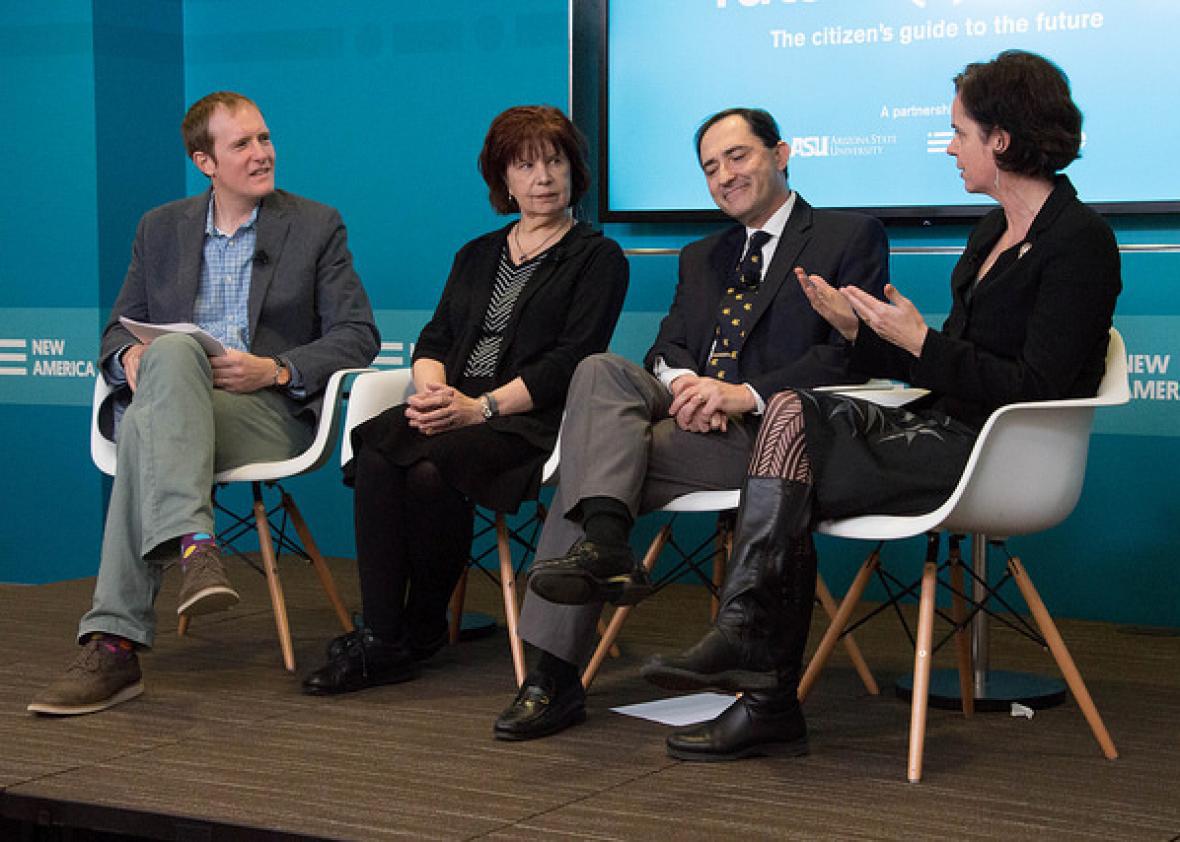Since Mary Wollstonecraft Shelley published Frankenstein in 1818, the novel has spawned countless derivatives, from films and musicals to Scooby-Doo episodes and sugary breakfast cereals. Almost two centuries later, it could be argued that no other work of literature has done more to shape the way people think about science and its moral consequences. But it’s not clear what lesson, exactly, Shelley hoped to impart on her readers. Is Frankenstein’s monster a cautionary tale of hubris and science to go too far? Or is that too simplistic an interpretation?
On Feb. 2, Future Tense convened experts in Washington, D.C., to discuss the ways in which Victor Frankenstein and his monster influence how we think about research and innovation—and how it can help us weigh the benefits of innovation against their unintended consequences.
The event kicked off with a discussion of what it means to “play God,” opened by a presentation from Patric M. Verrone, writer and producer for Futurama, who recalled that his own journey into animation began when he heard a writer say, “When we are creative, we are our most godlike.” Verrone and moderator Ed Finn, director of the Center for Science and the Imagination at Arizona State University, riffed on the idea that in writing Frankenstein, Shelley didn’t just tell a story of creation. She spawned endless creation itself by giving popular culture a trope, a series of gestures (a pulled switch followed by lightening), and language (like portmanteaus involving franken-). “I believe quite firmly that Mary Shelley meant this to be the impact,” Verrone said in his opening remarks:
In Shelley’s mind, Frankenstein was the modern Prometheus: a hip, up-to-date, vital god who chose to create human life and paid the dire consequence. To Shelley, gods create and for humans to do that is bad, bad for others, but especially bad for one’s own creator.
When asked whether the ubiquity of the trope had caused it to lose its moral force, Hugo Award-winner and science fiction writer Nancy Kress responded that it was more relevant now, with the advent of technologies like genetic engineering. “What we have available today are, perhaps, genuine godlike powers,” she said. “There is an enormous potential [in genetic engineering] and an enormous danger, and neither one is particularly well understood, which is also true of Mary Shelley’s monster.”
Josephine Johnston, director of research at the Hastings Center, stressed that bioethics as a field has largely vacated the concept of playing god, as it necessarily relies too heavily on theology. Still, she suggested that other notions wrapped up in the concept are relevant today. If safety were not an issue, if Frankenstein’s monster had the disposition of Pollyanna, what other moral dilemmas do the creation of a human-adjacent creature pose? What does it mean to have complete dominion over an invention that can, at the very least, simulate cognition?
In the second panel, engineer and naval officer Cara LaPointe underscored that point, remarking that the primary question that underlies the trope of playing God—to create or to not create—is largely obsolete. We have already decided to create, as evidenced by artificial intelligence, automation, and genetic engineering. These technologies suggest that perhaps the warning we take from Frankenstein should be about how we create. Susan Tyler Hitchcock, author of Frankenstein: A Cultural History, argued that the lore and culture surrounding the novel had done it a disservice, turning the moral into an admonition against creation rather than a warning against bad science.*
Hitchcock and LaPointe agreed with their fellow panelist Samuel Arbesman, scientist-in-residence at Lux Capital, that the best way to mitigate the unintended consequences of technology was through collaboration. Frankly, Victor Frankenstein was a bad scientist. He worked in isolation, with no peer oversight or review, and abandoned his creation as soon as the going got rough. LaPointe advocated for crowdsourcing innovation, diversifying the tech development process, and including nonscientists in discussions about research. Humility in the face of technology—which Arbesman described as halfway between the natural awe that follows innovation and the complete disdain or fear that Frankenstein regarded his monster with—would also go a long way.
Jacob Brogan, editorial fellow at New America, launched the last panel by arguing that that it is not the novelty of technology that scares us. Expanding on the Freudian concept of the uncanny, he suggested that the more we learn, the more alien the things we already know seem to be. Technology serves to show us how much larger—and stranger—the world is than we expect. Charlotte Gordon, author of Romantic Outlaws: The Extraordinary Lives of Mary Wollstonecraft and Her Daughter Mary Shelley, said that another reading of Shelley’s novel would reflect a fear not of an unknown technology, but of the society in which she was raised.
If Shelley would have sympathized with anyone in Frankenstein, it would be the monster. Gordon noted that as an unwed mother, the female author of a truly gruesome book in 19th-century England, and the daughter of radical feminist Mary Wollstonecraft and political theorist William Godwin, Shelley was uniquely positioned to be ostracized from general society and to understand the sociopolitical ramifications of that gender-based exclusion. By creating the monster, Shelley was attempting to make the rules society abided by strange to those that accepted them without question. “As she’s writing Frankenstein, Mary Shelley is thinking less about technology than she is the social ills that she has endured,” Gordon said. “She’s really describing a world in which there are no mothers, in which the ideals of femininity as she knew it did not exist.”
Watch the full event on the New America website. You can also read Future Tense’s series on Frankenstein.
*Correction, Feb. 8, 2017: This post originally misspelled Susan Tyler Hitchcock’s middle name.
